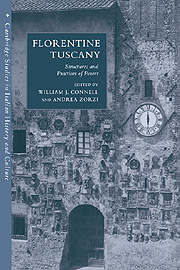Book contents
- Frontmatter
- Contents
- List of figures
- List of tables
- List of abbreviations of archival sources
- Introduction
- 1 The ‘material constitution’ of the Florentine dominion
- 2 The language of empire
- 3 Constitutional ambitions, legal realities and the Florentine state
- 4 Fiscality, politics and dominion in Florentine Tuscany at the end of the middle ages
- 5 Market structures
- 6 State-building, church reform and the politics of legitimacy in Florence, 1375–1460
- 7 The humanist citizen as provincial governor
- 8 Territorial offices and officeholders
- 9 Demography and the politics of fiscality
- 10 Florentines and the communities of the territorial state
- 11 Patronage and its role in government: the Florentine patriciate and Volterra
- 12 San Miniato al Tedesco: the evolution of the political class
- 13 The social classes of Colle Valdelsa and the formation of the dominion (fourteenth–sixteenth centuries)
- 14 Arezzo, the Medici and the Florentine regime
- 15 Rubrics and requests: statutory division and supra-communal clientage in Pistoia
- 16 A comment
- Index
- CAMBRIDGE STUDIES IN ITALIAN HISTORY AND CULTURE
15 - Rubrics and requests: statutory division and supra-communal clientage in Pistoia
Published online by Cambridge University Press: 16 September 2009
- Frontmatter
- Contents
- List of figures
- List of tables
- List of abbreviations of archival sources
- Introduction
- 1 The ‘material constitution’ of the Florentine dominion
- 2 The language of empire
- 3 Constitutional ambitions, legal realities and the Florentine state
- 4 Fiscality, politics and dominion in Florentine Tuscany at the end of the middle ages
- 5 Market structures
- 6 State-building, church reform and the politics of legitimacy in Florence, 1375–1460
- 7 The humanist citizen as provincial governor
- 8 Territorial offices and officeholders
- 9 Demography and the politics of fiscality
- 10 Florentines and the communities of the territorial state
- 11 Patronage and its role in government: the Florentine patriciate and Volterra
- 12 San Miniato al Tedesco: the evolution of the political class
- 13 The social classes of Colle Valdelsa and the formation of the dominion (fourteenth–sixteenth centuries)
- 14 Arezzo, the Medici and the Florentine regime
- 15 Rubrics and requests: statutory division and supra-communal clientage in Pistoia
- 16 A comment
- Index
- CAMBRIDGE STUDIES IN ITALIAN HISTORY AND CULTURE
Summary
In the twentieth chapter of The Prince, Machiavelli famously observed: ‘Our ancestors and those who were considered wise used to claim that it was necessary to hold Pistoia with factions and Pisa with fortresses, and consequently nurtured differences in several subject cities in order to keep hold of them more securely.’ What this assertion masks is a fundamental difference in the manner by which these so-called parte were managed during the course of the fifteenth century, for almost continuously between 1376 and 1457 Pistoia's offices were equally divided by statute between the societies of San Paolo and San Giovanni. The purpose was to secure civic peace through the equitable distribution of honours as enshrined in legislation. With the establishment of Medicean hegemony in Florence, however, the dissolution of the statutory ‘parte’ in Pistoia meant that communal peace was dependent on the impartiality of the Medici and their agents in their role as patron/arbitrators between competing elements within the Pistoiese elite. An examination of the Pistoiese case sheds interesting light on the changing nature of power brokerage within and between both Pistoiese and Florentine elites during the course of the Quattrocento.
RECONFIGURING THE POLITICAL LANDSCAPE
In 1376 Florentine ambassadors annulled the Pistoiese's own civic reforms in an attempt to pacify the city, and mandated four commissioners to carry out a new reform to last six years, doubling the number of bags for the major civic offices from four bags per office, one per quarter, to eight.
- Type
- Chapter
- Information
- Florentine TuscanyStructures and Practices of Power, pp. 312 - 332Publisher: Cambridge University PressPrint publication year: 2000
- 1
- Cited by



